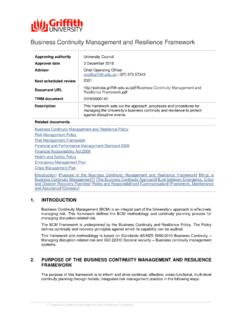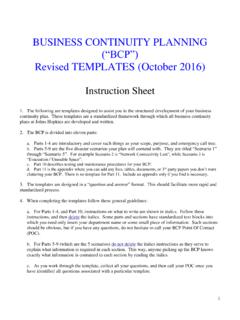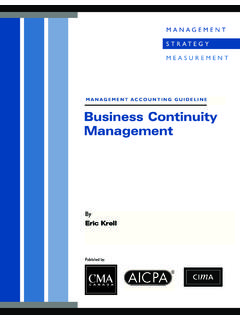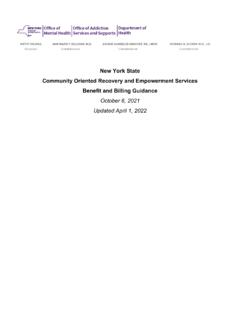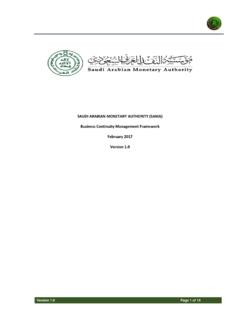Transcription of Recommendations for Crisis Management - UIC
1 Recommendations for Crisis Management April 2017. 2016 UIC Additional Global Security Programme Recommendations for Crisis Management Definitions and Acronyms Crisis Crisis Management A Crisis is a sudden event or set of circumstances that could significantly affect an Crisis Management (CM) is organization's ability to carry out the overall coordination of an its business, that damages an organization's response to a Crisis , organization's reputation and/or in an effective, timely manner, with threatens the environment, the the goal of avoiding or minimizing health, safety, and well-being of damage to the organization's employees, customers, or the profitability, reputation, or ability public at large. If not handled in an to operate and often involves the appropriate and timely manner (or need to make quick decisions if not handled at all), a Crisis may on the basis of uncertain or turn into a disaster or catastrophe.
2 Incomplete information. Crises are deemed to be negative CM includes the development changes in the security, economic, of plans, based upon an integral political, societal, or environmental approach with internal and affairs, especially when they occur external organizations, to reduce abruptly, with little or no warning. the risk of a Crisis occurring and to deal with any crises that do arise, and the implementation of these plans so as to minimize the impact of crises and assist the organization to recover from them List of and restart its normal activities as quickly as possible. Recommendations for Crisis Management Coordinator: Jochen Grimmelt abbreviations Editor: Security Division, Layout and production: Marina Grzanka, graphic designer, CM: Crisis Management ISBN: 978-2-7461-2602-2.
3 CMT: Crisis Management Team Warning: No part of this publication may be copied, reproduced or distributed by any means whatsoever, including electronic, HR: Human Resources except for private and individual use, without the express permission of the International Union of Railways (UIC). The same applies for translation, adaptation or transformation, arrangement or reproduction by any method or procedure whatsoever. CEO: Chief Executive Officer The sole exceptions noting the author's name and the source are analyses and brief quotations justified by the critical, argumentative, educational, scientific or informative nature of the publication into which they are incorporated (Articles L 122-4 BU: Business Unit and L122-5 of the French Intellectual Property Code). CSO: Chief Security Officer International Union of Railways (UIC) Paris, April 2017.
4 3. Recommendations for Crisis Management Recommendations for Crisis Management Contents DEFINITIONS AND ACRONYMS 3. 1. INTRODUCTION 6. 2. METHOD 8. 3. Crisis Management PLAN 9. Risk Analysis 9. Priorities in Crisis Management 10. Structure and Content of a Crisis Management Plan 11. Alert Levels 14. Composition of the Crisis Management Team 17. Central Crisis Management Team 17. Extended Crisis Management Team 21. Regional, Local or Business-Related Crisis Teams 21. Working Groups 22. Endurance 22. Crisis Management Infrastructure 23. Crisis Communication 25. Incident and Situation Reporting 25. Exemplary Information Matrix Communication Priorities 26. Information Policy and Requirements 27. Codewords 28. Terminology 28. Public Communication 28. Training 29. Communication/Alert Exercises 29.
5 Tabletop Exercises 29. Command Post Exercises 30. Full (Live) Exercise 31. Cooperation 32. Evaluating and Updating your Crisis Management Plan 33. 4 CONCLUSION 34. 5 OUTLOOK 34. 6 ANNEX 35. Checklists 35. Crisis Management Team Meeting Agenda 35. Crisis Management Team Meeting Minutes 37. 4 5. Recommendations for Crisis Management Recommendations for Crisis Management 1. Introduction During the 11th Security Congress in New Delhi, UIC was asked by its members to provide a benchmark study about the Crisis Management efforts within the railway community. VIA Rail Canada Norwegian National Rail This request was embedded in an additional security program1 and was completed from March Trafikverket 2016 to October 2016, in cooperation with UIC and its members. During a workshop on Crisis SJ AB.
6 Management that took place during the Security Week, hosted by UIC from to , UIC was asked by its members to provide additional Recommendations for Crisis JSC RZD / FPC. Management efforts and requirements. JSC NC Kazakhstan temir zholy TUNISIAN NATIONAL RAILWAY. The results and the required documentation were ready by October 2016 and introduced East Japan Railway Company ONCF. during the Security Congress in Helsinki. West Japan Railway Company UIC thanks all members who participated in the Study, in the interviews and review, and who Israel Railways contributed to the completion. Indian Railways Deutsche Bahn LATVIAN RAILWAY. Additionally, we would like to thank COLPOFER and UITP for participating and co-authoring JSC LITHUANIAN RAILWAYS . Thalys this document. SNCF. PKP Intercity BB. SBB.
7 ZSSK / ZSSK Cargo EUSKOTRENBIDEAK-FERROCARRILES. VASCOS Graz-K flacher Bahn und Busbetrieb GmbH. Renfe-Operadora H CARGO Comboios de Portugal SLOVENSKE ELEZNICE, Administrador de Infraestructuras Ferroviarias TCCD. Together with a) information exchange on international trains and b) training of security and non-security staff 6 7. Recommendations for Crisis Management Recommendations for Crisis Management 2. Method 3. Crisis Management Plan Transport operators must be aware that if you operate things will happen . So better be A Crisis Management Plan should be considered as a superordinated document with underlying prepared. emergency plans. It provides overall organizational and general procedural guidelines for the Management of information, activities, operations, and communications during an escalating The following Chapters should assist rail operators in developing a Crisis Management Plan, emergency.
8 It is the basis for the decision-making process of the rail operator. or to check their existing plans for completeness. These Recommendations are based on the questionnaires provided by the members, additional interviews with selected members, Risk Analysis information and material on Crisis Management efforts provided by members, literature and internet research on good practices and the state of the art and The development of a Crisis Management Plan should start with an assessment of the the review of these Recommendations by selected members. potential vulnerabilities, risks, and threats facing a rail operator and the evaluation of the Crisis preparedness at the corporate, regional or local level. At least, the risks of incidents arising from: In consideration of the close interaction and the multiple interfaces between rail operators, infrastructure operators, public transport operators, and police authorities, UITP and Colpofer operations (accidents, collisions, derailments, fire, dangerous goods spillage), were also invited to review and co-author the document, rendering it into a guideline for all the environment (weather (snow, flooding, storm, ice), earthquakes), types of operators.
9 Actions by third parties (strikes, damage to infrastructure, rolling stock), Accordingly, within this document, the term Operators encompasses all types of rail, attacks by third parties (arson, sabotage, bomb threats, violence against customers and infrastructure and public-transport operators, represented by UIC, Colpofer, and UITP. employees, cyber-attacks). This is not intended as just another document about Crisis Management , but as a practical should be considered2. approach, giving rail operators as much concrete and practical advice as possible. The Recommendations take into account the different sizes and abilities of rail operators, aiming at a level that should be considered as the minimum efforts. Refer to Chapter Experiences in Crisis Management 8 9. Recommendations for Crisis Management Recommendations for Crisis Management Priorities in Crisis Management Structure and Content of a Crisis Management Plan One of the most important issues of a Crisis Management Plan is the operator's philosophy for handling the crises.
10 Specifically, what does the operator regard as its top priority during a Crisis ? All decisions made and actions taken should be checked against this philosophy. When a Crisis Management Plan is being developed, the following items/topics should be These priorities could be: addressed, based on the vulnerability, risk, and threat assessment. If a Crisis Management Plan is already in place, it should be evaluated and checked if additional topics can be 1. Saving lives and preventing serious injuries addressed. The following structure is a suggestion only, which can be adapted and adjusted 2. Minimizing damage to the environment, property and assets as needed. 3. Protecting the operator's reputation/image 4. Business continuity /returning to normal operations Saving lives and preventing serious injuries should always be the top priority and not Item Description/Keywords negotiable.





